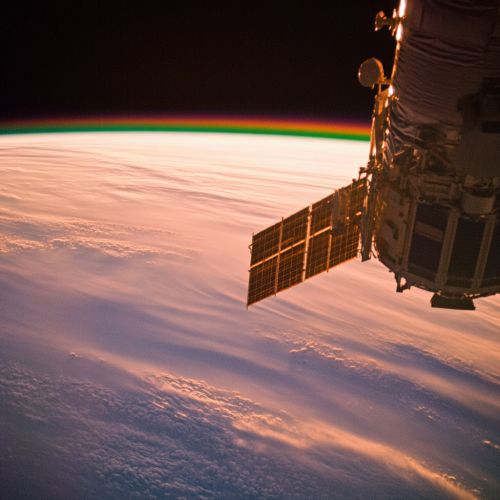Tropospheric Emission Spectrometer
Overview
The **Tropospheric Emission Spectrometer (TES)** is an advanced instrument designed to measure the chemical composition of the Earth's troposphere. It was launched aboard NASA's Aura satellite in 2004 as part of the Earth Observing System (EOS). TES provides detailed information on the distribution and concentration of various trace gases, which are crucial for understanding atmospheric chemistry, air quality, and climate change.
Instrumentation and Design
TES is a high-resolution infrared spectrometer that operates in the thermal infrared region of the electromagnetic spectrum. It employs a Fourier Transform Spectrometer (FTS) to achieve high spectral resolution, allowing it to distinguish between different molecular species based on their unique absorption features.
Spectral Range and Resolution
TES covers a spectral range from 650 to 3050 cm^-1, which includes significant absorption bands for key atmospheric gases such as ozone, carbon monoxide, methane, and water vapor. The instrument achieves a spectral resolution of 0.1 cm^-1, enabling precise identification and quantification of these gases.
Optics and Detectors
The optical system of TES includes a telescope, interferometer, and detectors. The telescope collects incoming radiation and focuses it onto the interferometer, which modulates the light to produce an interference pattern. This pattern is then detected by a set of cryogenically cooled detectors, which convert the infrared radiation into electrical signals for further processing.


Data Products and Applications
TES generates several data products that are used by scientists to study various aspects of the Earth's atmosphere. These products include vertical profiles of gas concentrations, surface emissions, and cloud properties.
Vertical Profiles
One of the primary data products from TES is the vertical profile of trace gas concentrations. These profiles provide information on the distribution of gases at different altitudes within the troposphere. This is essential for understanding processes such as photochemical smog formation, ozone depletion, and the transport of pollutants.
Surface Emissions
TES also measures surface emissions of gases like methane and carbon monoxide. These measurements help identify sources of pollution and natural emissions, contributing to our understanding of the global carbon cycle and the impact of human activities on the atmosphere.
Cloud Properties
In addition to gas measurements, TES provides information on cloud properties, including cloud height, optical depth, and phase (liquid or ice). These data are important for studying the role of clouds in the Earth's radiation budget and their influence on climate.
Scientific Contributions
TES has made significant contributions to our understanding of atmospheric chemistry and dynamics. Some key scientific findings from TES data include:
Air Quality
TES has provided valuable insights into the distribution and transport of air pollutants. For example, it has been used to track the movement of carbon monoxide plumes from wildfires and urban pollution, helping to improve air quality models and forecasts.
Climate Change
By measuring greenhouse gases such as methane and ozone, TES has contributed to our understanding of their role in climate change. The data have been used to study the sources and sinks of these gases, as well as their interactions with other components of the climate system.
Stratosphere-Troposphere Exchange
TES has also enhanced our knowledge of the exchange of gases between the stratosphere and troposphere. This exchange is important for understanding the distribution of ozone and other trace gases, which have implications for both air quality and climate.
Technical Challenges and Innovations
The development and operation of TES have involved several technical challenges and innovations. These include the design of the high-resolution interferometer, the cooling of the detectors to cryogenic temperatures, and the processing of large volumes of data.
Interferometer Design
The interferometer in TES is a critical component that determines the instrument's spectral resolution. It uses a Michelson interferometer design, which splits the incoming light into two beams that travel different optical paths before recombining to produce an interference pattern. This design allows for precise control of the optical path difference, enabling high spectral resolution.
Cryogenic Cooling
The detectors in TES are cooled to cryogenic temperatures (around 70 K) to reduce thermal noise and improve sensitivity. This requires a sophisticated cooling system that can maintain stable temperatures over long periods of time, even in the harsh environment of space.
Data Processing
TES generates large volumes of data that must be processed to extract meaningful information. This involves complex algorithms for Fourier transformation, radiative transfer modeling, and retrieval of gas concentrations. The data processing pipeline has been optimized to handle these tasks efficiently, ensuring that high-quality data products are available to the scientific community.
Future Directions
The success of TES has paved the way for future missions and instruments that will continue to advance our understanding of the Earth's atmosphere. Some potential future directions include:
Enhanced Spectral Resolution
Future instruments may achieve even higher spectral resolution, allowing for more precise measurements of trace gases and their isotopes. This could provide new insights into atmospheric processes and the sources and sinks of greenhouse gases.
Expanded Spectral Range
Expanding the spectral range of future instruments could enable the detection of additional gases and aerosols, further enhancing our understanding of atmospheric composition and chemistry.
Improved Spatial Resolution
Higher spatial resolution would allow for more detailed mapping of gas concentrations and emissions, providing better information on local sources of pollution and their impacts on air quality and climate.
